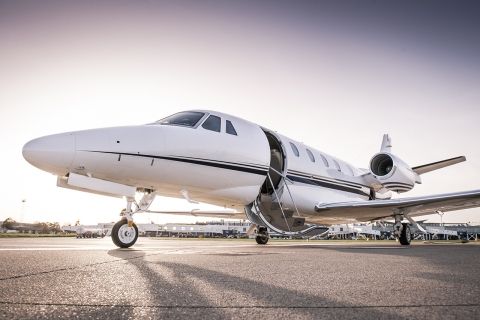
In the context of the 17th edition of the European Business Aviation Convention & Exhibition (EBACE), taking place between 22 and 24 May in Geneva, we've taken a chronological look at the evolution of the business aviation sector over the past 10 years, noting some positive recent trends, as well as making an initial assessment of some of the challenges the sector faces in the years ahead.
Business aviation ('BizAv' in short) is an air transport option that includes some commercial 'for hire' or fractional operations, flying corporate-owned jets and owner-operated flying for business purposes. Since there is no 'best' definition, EUROCONTROL's Statistics and Forecast Service (STATFOR) simply categorises flights by aircraft type (with a selection on the ICAO flight type, for some).
BizAv is the third largest market segment in Europe, after the traditional scheduled and low-cost segments. While being a much smaller market segment in comparison with commercial air travel, it nevertheless has a significantly positive economic impact as it generates jobs and, indirectly, stimulates commerce.
Compared to the main market segments, BizAv flies from smaller airports, and is characterised by a very large number of routes focusing on city pairs where there is no daily scheduled service.
A decade of ups and downs (2007-2016)
This market segment expanded rapidly from 2002 to 2007, contributing to the total growth of flights in Europe. However, following the economic crisis in 2008, the segment dropped 14% the following year. It recovered in 2010 (+5%) and 2011 (+2.4%), but declined again by 1.2% on average between 2012 and 2015.
Over the last 10 years, the market share of business aviation has fluctuated around 7% of all flights (variations between 7.7% in 2007 to 6.7% in 2016).
In 2016, business aviation recorded a small decrease of 0.2% in flights although it ended the year (November and December) with a growth rate of 4%. For most of the year, the business aviation market was affected by the atmosphere of uncertainty created by Brexit and a decrease of flows to/from the Russian Federation.
In Europe, 63% of the total business aviation flights were concentrated in five countries: France, United Kingdom, Germany, Italy and Switzerland.
In 2016, the top three pairs were Geneva - Le Bourget, Nice - Le Bourget and Milan Linate - Rome Ciampino. The top five airports for the same year are shown in the infographic. In terms of type of aircraft, the C56X Cessna Citation Excel (jet) has taken over the mantle from the BE20 Beechcraft King Air (turboprop) as the top business aviation aircraft type, with a difference of 500 flights. The biggest change is the appearance of the PC12 Pilatus (turboprop single engine) in third place for the first time in a decade.
Recent trends and challenges ahead
At the end of 2016, the sector started showing promising signs of vigour. For the first quarter of 2017, BizAv recorded 6% growth compared to the same period in 2016. This is mainly due to a robust increase in flows within Europe, with France and UK contributing most to this growth. STATFOR forecasts an average annual growth rate of +2.3% for the period 2017-2023.
At the European Business Aviation Association's (EBAA) annual press conference, Brandon Mitchener, CEO of EBAA, noted: "We've now had six months of steady growth in traffic numbers and they're the best since 2011. This is an exciting time for business aviation, with innovative new aircraft, technologies and business models coming to the fore. The industry is looking dynamic as it expands its offerings for new and existing customers and aircraft owners."
Nevertheless, European business aviation faces three main challenges. The first is constantly changing aviation regulations - compliance with them is potentially expensive. Second, having the right level of access to small airports is key, in particular because of the shortage of airports with navigation aids that make such airports accessible in all weathers. Third, there is a need to attract new customers. Looking to the future, political turbulence or by technology and disruptive business models may add to these challenges.
New possibilities for growth are opening up, following the European Aviation Safety Agency's (EASA) recent approval of new European single-engine turboprop aircraft rules for commercial operations in Europe. These aircraft have the same range and capacity as some business jets, and will make business aviation more affordable, making private flights available to a much wider audience. In turn, users will have more options like being able to avoid congested airfields. They will also be able to land closer to their real destinations rather than having to go through hubs first.